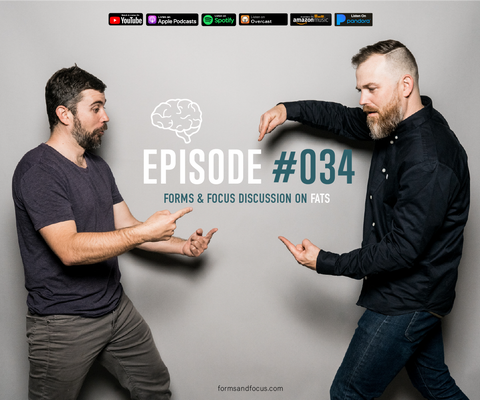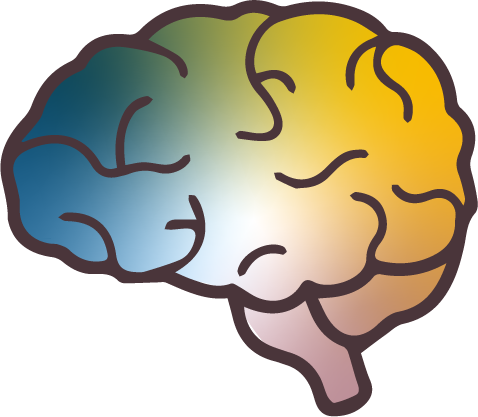
#34 Forms and Focus Discussion on Fats
Fats and Focus
Bro, you like butter? Well, you better take care of that scull butter because the brain about 60% fat. Certain fats have been shown to improve memory and cognitive functions, while others increase the risk of heart disease. Today on F&F episode… we’re talking about fats and focus.
0:00 Intro to Fat
0:40 Intro to Podcast
1:18 How Fats Effects Focus
13:45 Solution to Increasing Creativity
LISTEN
WATCH
SHOW NOTES EPISODE #34
STATS
- The brain is 60% fat, 40% water, protein and carbs.
- Your brain is not made from “storage fats” but “structural fat” (if your brain was storage fat your body would eat it if it was starving)
- Fats are comprised of a glycerol head with 3 fatty acid tails which is a hydrocarbon chain. (a carbon skeleton bound by hydrogen atoms)
- There are 9 calories in every gram of fat, regardless of type.
- There are 4 main categories of dietary fats
- Saturated Fats: When all carbon atoms are fully bound to hydrogen atoms. Because of this structure they are solid at room temperature. (Butter, tallow)
- Unsaturated fats: Some carbon atoms bind to each other as a double bond, so the fatty acid tail is “bent”. (olive oil, peanut oil)
- Monounsaturated fats: Fat molecule with only 1 double bond. (Mono for One)
- Polyunsaturated fats: Fat molecule with more than 1 double bond.
- Trans fats: (margarine, vegetable shortening)
- The body can synthesize all the fatty acids it needs except for omega-3 and omega-6 hence being called essential fatty acids. These must be consumed.
- Good Fats: Certain unsaturated fats increase HDL levels (good cholesterol) while reducing LDL levels (bad cholesterol)
- Neutral/bad: Saturated fats can raise levels of good and bad cholesterol.
- The worst fat of all: Trans fat. Trans fat is a type of unsaturated fat that is solid due to the carbon hydrogen structure. Trans fats lower good cholesterol and raise bad cholesterol. They rarely occur in nature so the body does not have the necessary enzymes to break them down.
- Found mostly in partially hydrogenated oils. This is where you add hydrogen as a catalyst to make liquid oils solid. This process extends shelf life of the fat
THE FUNCTION OF FATS IN THE BODY
- In the diet, fat is a carrier for the fat-soluble vitamins A, D, E and K, and supports their absorption in the intestine. Consuming sufficient amounts of fatty foods that contain these vitamins is thus essential for adequate intake of these micronutrients. European Food Information Council (EUFIC)
- Essential fatty acids (EFAs) are required for maintenance of optimal health but they can not synthesized by the body and must be obtained from dietary sources. Clinical observation studies has related imbalance dietary intake of fatty acids to impaired brain performance and diseases. (pubmed)
- Beyond their important role in building the brain structure, EFAs, as messengers, are involved in the synthesis and functions of brain neurotransmitters. (pubmed)
- Omega-3s seem to have a stabilizing effect on the heart. They can lower heart rate and help prevent arrhythmias (abnormal heart rhythms). Webmd
- Omega-3s DHA and EPA can lower your triglycerides, a blood fat that’s linked to heart disease. Talk with your doctor before taking omega-3 supplements, because some types can make your "bad" cholesterol worse
- Omega-3 foods and supplements curb plaque buildup inside blood vessels, helping with blood flow. So they may help prevent stroke caused by clots or a blocked artery. WebMD
- There are different types of omega-3s: ALA (alpha-linolenic acid), DHA (docosahexaenoic acid), and EPA (eicosapentaenoic acid)
- Your body can turn ALA into DHA and EPA, though not very efficiently (only about 15% of the plant-based ALA can be converted to DHA and EPA in the body). So, many dietitians recommend getting DHA and EPA from supplements (WebMD)
SOLUTION
Fatty fish is the best source of Omega 3
Anchovies, mackerel, herring, sardines, oysters, salmon
Plant oils: Plant oils (such as flaxseed oil, soybean oil, and canola oil)
Nuts and seeds (such as flaxseed, chia seeds, and walnuts)
Supplementation: fish oil, krill oil, cod liver oil, and algal oil (a vegetarian source that comes from algae)
FIND US AT
https://formsandfocus.com/
https://www.instagram.com/formsandfocus/ https://www.tiktok.com/@formsandfocus
#focus #fat #dream

Comments (0)
There are no comments for this article. Be the first one to leave a message!